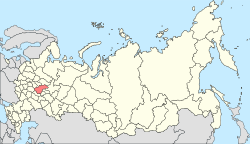Sarov
| Sarov (English) Саров (Russian) |
|
|---|---|
| - Town - | |
 Location of Nizhny Novgorod Oblast in Russia |
|
|
|
|
|
|
|
|
|
|
| Administrative status (as of November 2011) | |
| Country | Russia |
| Federal subject | Nizhny Novgorod Oblast |
| Administratively subordinated to | town of oblast significance of Sarov |
| Administrative center of | town of oblast significance of Sarov |
| Municipal status (as of December 2006) | |
| Urban okrug | Sarov Urban Okrug |
| Administrative center of | Sarov Urban Okrug |
| Statistics | |
| Population (2010 Census) | 92,047 inhabitants |
| - Rank in 2010 | 185th |
| Time zone | MSK (UTC+03:00) |
| Town status since | 1954 |
| Previous names |
Arzamas-16 (until 1991), Kremlyov (until 1995) |
| Postal code(s) | 607188 |
| Dialing code(s) | +7 83130 |
|
|
|
| on | |
Sarov (Russian: Саро́в) is a closed town in Nizhny Novgorod Oblast, Russia. It was known as Arzamas-16 (Арзама́с-16) from 1946 to 1991. Until 1995, it was known as Kremlyov (Кремлёв). The town is closed as it is the Russian center for nuclear research. Population: 92,047 (2010 Census);87,652 (2002 Census).
The history of the town can be divided into two different periods. In the earlier history of Russia it was known as one of the holy places of the Russian Orthodox Church, because of its monastery, that gave Russia one of its greatest saints, St. Seraphim. Since the 1940s, it has gradually become the center for research and production of Soviet and later Russian nuclear weapons.
The history of human settlement in the area around Sarov goes back at least to the 12th–13th centuries, when a large Mordvin settlement was founded on its spot. In 1298, the town was taken over by Tatars.
The modern town took its name from being the site of the Sarov Monastery next to the Sarov River. In 1664, an Orthodox monk Theodosius first settled on the Sarov hill. The first Church of Sarov tenement was founded in 1706. Saint Seraphim was living in Sarov from 1778 to 1833. In 1903, the monastery was visited by Tsar Nicholas II and other members of the royal family. At that time the monastery had nine churches, including one underground. Around 320 monks lived in the monastery.
In 1923 the monastery was closed, the monks faced Bolshevik repressions, and many were executed. During World War II, the monastery buildings were used as factories for producing rockets for BM-13 "Katyusha" rocket launchers.
...
Wikipedia


